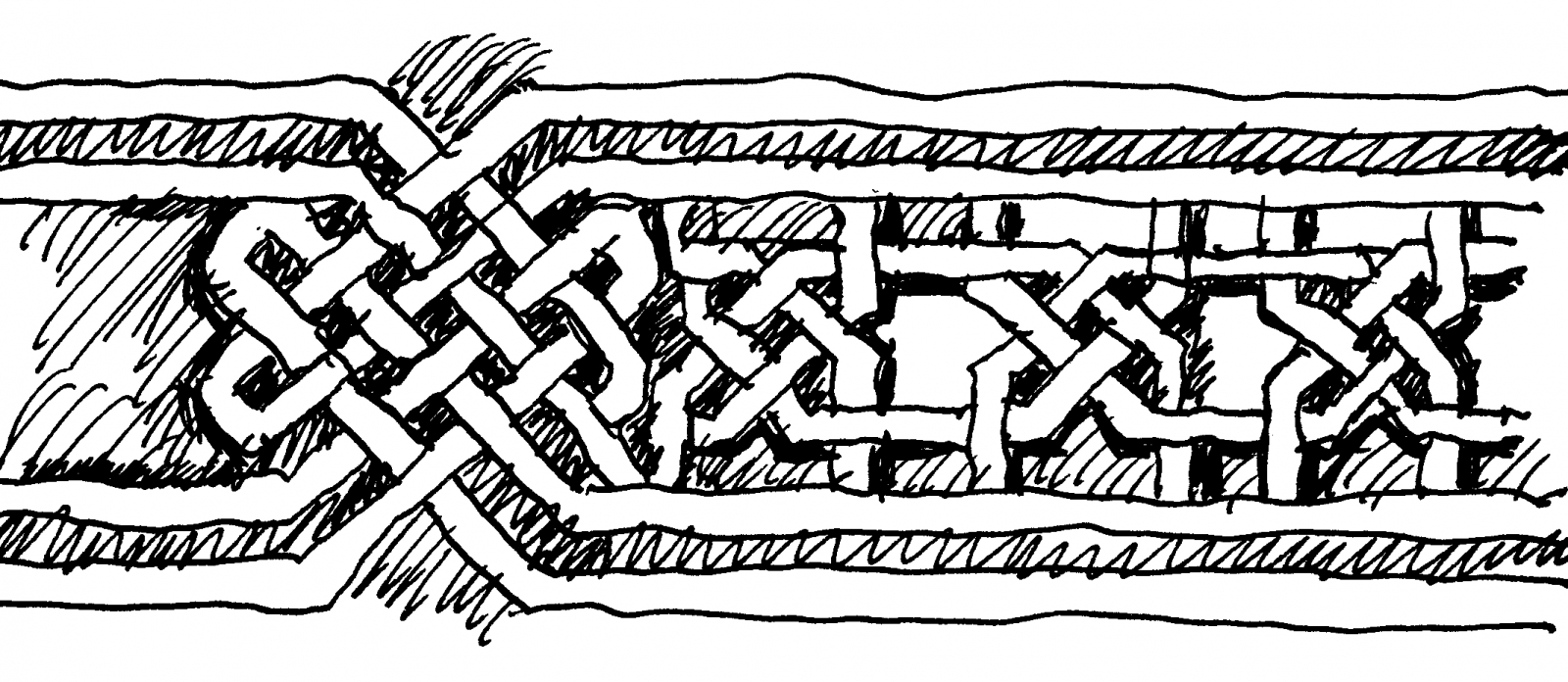
September 8, 2015
Why Do We Create Ornament to Mimic Nature?
In the seventh installment of the ten-part Biophilia and Healing Environments series, we learn how ornament that is coherent with the rest of a structure helps connect people to their environment, and create a positive, healing atmosphere.
An example of ornament clearly derived from plant forms, yet with many more symmetries than in real plants.
Drawing by Nikos Salingaros
Living in an artificial environment makes us long for nature. We make up for its lack by imbuing our surroundings with those geometric qualities found in nature (Salingaros, 2006; 2013: Chapter 19). We try to shape our immediate vicinity so that those qualities reproduce our response to natural environments. When we cannot have immediate access to plants and animals, the next best thing is to create ornament. This compulsion has nothing to do with architectural style in principle, though in practice the result can eventually define a style. (Architects who look down their noses at ornament tend also to look down their noses at style, even as their rationale for opposing ornament amounts to style.)
Ornament often mimics nature directly. Organic forms copied from plant life define a broad category of ornament seen throughout history and across cultures. From biophilia, natural forms have inherent qualities, reducible to a mathematical description, that induce a healing effect. Other types of ornament bear no direct resemblance to natural forms but rely instead on more abstract geometries. Here the healing effect comes not by direct biological imitation but by triggering human biology’s positive emotional responses through symmetry, contrast, detail, and color (Salingaros, 2013: Chapter 16).
Ornament is simply the organization of complexity generated at the smaller scales of design (Salingaros, 2014). Humans copy the designs of nature but also impose additional ordering, symmetry, and coherence on the artifacts they make or buy. Or we begin with a naturalistic resemblance but then develop those symmetries much further. Phenomena related to how global coherence resists entropy begin to operate at larger design scales (Alexander, 2001-2005; Salingaros, 2006). The difference between ornament that looks organic and ornament that looks abstract and the reason why both contribute to biophilia need investigating. Among those writing about this topic are Bruce Donnelly (2015) and Ann Sussman and Justin Hollander (2015).
Christopher Alexander (2001-2005) calls “living structure” those forms and artifacts of human design that mimic the geometrical properties and organized complexity of living organisms, which human beings seem eager to create. We generate and connect to very specific abstract designs on a small scale because we feel attracted to them viscerally. Why is this so? It’s obviously linked to an evolutionary advantage that subconsciously influences what we do and how we behave. The creative urge for ornament — unacknowledged by the dominant culture — is an essential part of our instinct for generating life through our own reproduction.

The tremendous emotional appeal of Arab-Islamic architecture relies in large part on its abstract ornament. This example is strictly geometric and not organic, yet works in a biophilic manner.
Drawing by Nikos Salingaros
In short, ornament is intimately linked to human intelligence. This might come as a shock to most architects trained to reject ornament on ideological grounds. Nevertheless, experiments with young animals show that complex environments dramatically increase brain size and performance on intelligence tests (Salingaros, 2013: Chapters 27 & 28). Anecdotal evidence shows similar results for human children as well, but it is ignored by architects who design schools more as a personal visual statement. The human brain is not wired to grasp the blank surfaces (Sussman & Hollander, 2015) often introduced in settings for children, as if simplicity rather than complexity — ornament and detail — were better nourishment for growing minds. It is not. This is one of many things that architects who disdain ornament don’t understand.
A positive, healing response to our environment occurs whenever we perceive in our surroundings certain characteristics akin to the organized complexity of nature common to traditional ornament. Our evolution has generated in human neurophysiology an innate need to create ornament. Rules for how ornament contributes to a healing environment can be derived from understanding how the brain is wired to respond to our surroundings. Using Alexander’s “Fifteen Fundamental Properties” as a starting point (Alexander, 2001-2005; Leitner, 2015; Salingaros, 2013: Chapter 19), I offer eight cognitive rules to judge whether a form — a building, a part of a building inside or out, or its neighborhood — is visually coherent and facilitates healing. These rules summarize the relationship between human cognition and our creation of ornament [the interested reader will find a more detailed discussion in (Salingaros, 2006: Chapter 4)]:
1. A region of contrast, detail, or curvature is necessary.
2. The center or the border should be well defined.
3. Attention is drawn to symmetric ornamental elements.
4. Linear continuity orders visual information.
5. Symmetries and patterns organize information.
6. Relating many different scales creates coherence.
7. Color is indispensable for our well-being.
8. We connect strongly to a coherent environment.
Different types of ornament that are coherent with the rest of a structure within a setting help connect people to their environment, and create a positive, healing feature of any building. Owner-built houses are often ornamented both on the inside and on the outside. Ornament in traditional and vernacular architecture satisfies the need for healing surfaces in spaces for living. This key phenomenon characterizes cultures all over the world. Even plain, ordinary buildings throughout history before the industrial age always used natural materials, and the healing/biophilic effect comes in part from that. For example, surfaces made of wood induce healing in stark contrast with surfaces made of aluminum, plastic, or steel (Sakuragawa et al., 2005; 2007).
Notwithstanding humans’ hardwired desire for ornament, it is no longer incorporated as a matter of course into the built environment. Curricula in the leading areas of design education, professional organizations that represent architects, designers and planners, and influential critics and journals that mold public opinion have imposed a virtual ban on ornament. In many quarters, the ideological rejection of ornament is an old story, no longer considered relevant — but not everyone is with the program (Mehaffy & Salingaros, 2015: Chapter 3). When such renegades mention the link between ornament and healing, most architects grow uneasy, even angry. Why? Their prejudices are being challenged. When thus affronted, they fall back on the claim that architecture is an art, and that scientific data are beside the point.
Readings:
Christopher Alexander (2001-2005) The Nature of Order, Books 1-4, Center for Environmental Structure, Berkeley, California. Book 1: The Phenomenon of Life, 2001; Book 2: The Process of Creating Life, 2002; Book 3: A Vision of a Living World, 2005; Book 4: The Luminous Ground, 2004.
Bruce Donnelly (2015) “Structured and Unstructured Space”, Accessplaces, 6 July 2015.
Helmut Leitner (2015) Pattern Theory, CreateSpace, Amazon.
Michael W. Mehaffy & Nikos A. Salingaros (2015) Design for a Living Planet: Settlement, Science, and the Human Future, Sustasis Press, Portland, Oregon and Vajra Books, Kathmandu, Nepal. Chapter 3 “How Modernism Got Square” was originally published in Metropolis, 19 April 2013.
Satoshi Sakuragawa, Y. Miyazaki, T. Kaneko & T. Makita (2005) “Influence of wood wall panels on physiological and psychological responses”, Journal of Wood Science, Volume 51, pages 136-140.
Satoshi Sakuragawa, T. Kaneko, Y. Miyazaki (2008) “Effects of contact with wood on blood pressure and subjective evaluation”, Journal of Wood Science, Volume 54, pages 107-113.
Nikos A. Salingaros (2006) A Theory of Architecture, Umbau-Verlag, Solingen, Germany; reprinted 2014, Sustasis Press, Portland, Oregon and Vajra Books, Kathmandu, Nepal. Chapter 4: “The Sensory Value of Ornament” originally appeared in Communication & Cognition, Volume 36, No. 3-4 (2003), pages 331-351.
Nikos A. Salingaros (2013) Unified Architectural Theory: Form, Language, Complexity, Sustasis Press, Portland, Oregon and Vajra Books, Kathmandu, Nepal. Chapter 16 (No. 10 online) “Biophilia: Our Evolved Kinship To Biological Forms” is republished in ArchDaily, 26 April 2015. Chapter 19 (No. 11 online) “Alexander’s Fifteen Fundamental Properties” is republished in ArchDaily, 2 May 2015. Chapter 27 (No. 12 online) “Ornament And Human Intelligence” is republished in ArchDaily, 16 May 2015. Chapter 28 “Intelligence and the Information Environment” was originally published in Metropolis, 25 February 2012.
Nikos A. Salingaros (2014) “Complexity in Architecture and Design”, Oz Journal, Volume 36, May 2014, pages 18-25.
Ann Sussman & Justin B. Hollander (2015) Cognitive Architecture, Routledge, New York.





